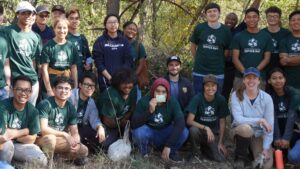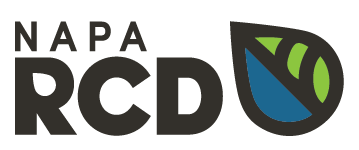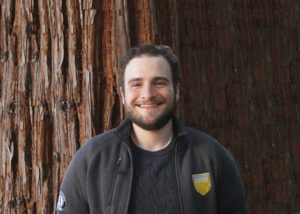 I’ve spent the past 11 months (September 2022 – July 2023) as a GrizzlyCorps fellow with Napa RCD. GrizzlyCorps is an AmeriCorps program designed by Project Climate at UC Berkeley’s Center for Law, Energy, and the Environment, in partnership with CaliforniaVolunteers. I was a member of a cohort of about 35 fellows serving at organizations throughout the state working in fire and forest resiliency and/or regenerative agriculture. In this capacity, I spent the year working as a member of Napa RCD’s Forest Health program. In this post, I want to share a little bit about what I’ve worked on this year.
I’ve spent the past 11 months (September 2022 – July 2023) as a GrizzlyCorps fellow with Napa RCD. GrizzlyCorps is an AmeriCorps program designed by Project Climate at UC Berkeley’s Center for Law, Energy, and the Environment, in partnership with CaliforniaVolunteers. I was a member of a cohort of about 35 fellows serving at organizations throughout the state working in fire and forest resiliency and/or regenerative agriculture. In this capacity, I spent the year working as a member of Napa RCD’s Forest Health program. In this post, I want to share a little bit about what I’ve worked on this year.
I came to Napa knowing relatively little about it – anything I had heard about Napa was in association with wine. While it’s true that viticulture is certainly a big part of Napa’s identity, there is much more to Napa than grapes and wine. Considered a biodiversity hotspot, about 18.5% of California’s plant species can be found here in Napa County, which makes up only about 0.5% of the state’s land area. This makes Napa a very exciting place to be doing resource conservation work.
I spent the year working with the Forest Health program, which has grown a great deal in the last few years. This growth is mostly because of the impact of wildfire – over 60% of Napa County has burned since 2017, so there is a lot of demand for wildfire resilience and mitigation work. The forest health program provides technical and financial assistance to landowners, works with partner organizations on planning and monitoring, and supports community engagement and education. Although there is a big focus on wildfire resilience, the program aims to take a holistic approach to forest health.
My overarching goal for the service year was to build Napa RCD’s capacity to help the community improve forest health and wildfire resilience by developing new resources and contributing to education and outreach efforts. These projects included developing resources about oak planting and care, doing research into monitoring, and creating a web map and stories about a forest health cost share program. I also provided general support to the outreach and education teams and participated in inventory and monitoring efforts.
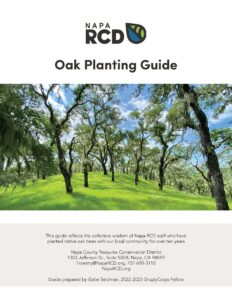 One of my big projects this year was developing an oak planting guide and video. Restoring native vegetation, particularly oak trees, is a big focus of Napa RCD’s programming. Napa County has lost a lot of its native oak habitat over the last 200 years or so because of development of orchards, vineyards, and towns – you can learn more about this here. Napa RCD has been planting oak trees from acorns for over a decade and has developed and refined a protocol for collecting, processing, and planting acorns. My job was to synthesize various instructions and handouts that have been developed over the years into one centralized, brand-consistent PDF guide. Along with the PDF guide, I also made a video showing the planting process from start to finish. The guide is intended to be used by anyone who wants to plant an oak tree, including landowners, community members, and partner organizations. Thanks to the help of Ruby, Napa RCD’s Conservation Project Manager, these materials could also be translated into Spanish.
One of my big projects this year was developing an oak planting guide and video. Restoring native vegetation, particularly oak trees, is a big focus of Napa RCD’s programming. Napa County has lost a lot of its native oak habitat over the last 200 years or so because of development of orchards, vineyards, and towns – you can learn more about this here. Napa RCD has been planting oak trees from acorns for over a decade and has developed and refined a protocol for collecting, processing, and planting acorns. My job was to synthesize various instructions and handouts that have been developed over the years into one centralized, brand-consistent PDF guide. Along with the PDF guide, I also made a video showing the planting process from start to finish. The guide is intended to be used by anyone who wants to plant an oak tree, including landowners, community members, and partner organizations. Thanks to the help of Ruby, Napa RCD’s Conservation Project Manager, these materials could also be translated into Spanish.
Another big project I worked on was researching best practices for monitoring tree plantings and other types of habitat enhancement. Napa RCD’s work in habitat restoration is scaling up, so there was a need to explore different ways of monitoring and tracking projects. The first part of this project involved reaching out to over ten organizations that work in tree planting or habitat enhancement and interviewing them about how they track and monitor their work. I took information from these interviews, synthesized it, and worked with RCD staff to begin developing a monitoring protocol and a geospatial framework for project data.
I also worked on developing a web map for the North Bay Forest Improvement Program (NBFIP), a cost-share incentives program for forest health work that Napa RCD administers along with other organizations in neighboring counties. The Outreach Committee for the program wanted to create a web map that shows where work has taken place to demystify the process for landowners who might be interested in the program. Working with the outreach committee, I developed a public-facing web map of projects. Along with the map, we conducted interviews with a couple of landowners about their experience with the program and created story maps from these interviews, which can be accessed from the web map.
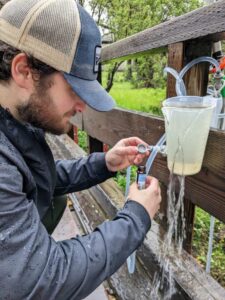
Throughout the year, I also supported field work where I could, especially in forestry. Since Napa RCD provides technical assistance, it is often necessary to visit properties and talk with landowners about the work they are doing or would like to do. This usually involves walking the property, taking reference photos, and sometimes completing forest inventories. I also got to help with fish monitoring. Napa RCD’s streams and habitat program monitors salmonid populations in the Napa River. These species, especially chinook and steelhead, are considered a key indicator of watershed health, and tracking their numbers can help evaluate the effectiveness of restoration work. To monitor them, the Napa RCD operates a rotary screw trap in the Napa River, which is basically a big water-powered rotating door that empties fish out into a box that gets checked each day. Everything that’s caught is documented and if a chinook or steelhead is caught, a genetic sample is collected and the fish is released back upstream.
I also provided general support in outreach and education. This included assisting with and leading field trips, volunteer workdays, workshops and webinars, developing outreach materials, and tabling outreach events. Some highlights included supporting and leading acorn plantings, helping to organize and lead a webinar about fire ecology, and tabling fun events like Earth Day Napa, Ag Day, an 8th grade career fair, and a wildfire resources fair.
One great thing about GrizzlyCorps is its focus on training. 20% of my service hours were available to be spent on training, which amounted to over 250 hours. I tried my best to take advantage of this opportunity. I took several online courses and workshops in GIS, data management, and outreach best practices. I also got my firefighter type 2 qualifications, took a wilderness first aid class, and the opportunity to attend a few professional conferences like the California Association of Resource Conservation Districts Annual Conference and the California Climate and Energy Forum.
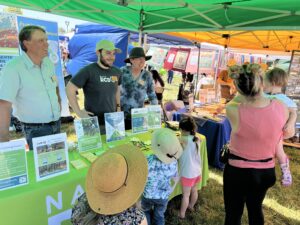 In reflecting on my service year, I want to zoom out a little bit to talk a little bit about the barriers and challenges that were present in my year of service. On the organizational side of things, at the beginning of the term I interviewed RCD staff about what they see as the biggest barriers to their work. The most common answers were challenges associated with funding structure, reach, and buy-in. Napa RCD relies fairly heavily on grants, which can slow things down and limit flexibility. In terms of reach, most RCD staff felt that the RCD does a great job of engaging their current audience, but it sometimes feels like they are preaching to choir and not reaching new audiences. On the personal side of things, I definitely dealt with a learning curve coming in. There was a lot to learn about the Napa RCD’s work and its structure, and I only recently have felt like I’ve had a good handle on it. Along with this learning curve came some imposter syndrome, where I didn’t feel like I knew enough to be doing the work. This was also a new type of job for me. For three years before this, I worked as a geospatial analyst, where I got a task, completed it, and moved on to the next one. This year I had to be a lot more open and flexible and set more of my own goals.
In reflecting on my service year, I want to zoom out a little bit to talk a little bit about the barriers and challenges that were present in my year of service. On the organizational side of things, at the beginning of the term I interviewed RCD staff about what they see as the biggest barriers to their work. The most common answers were challenges associated with funding structure, reach, and buy-in. Napa RCD relies fairly heavily on grants, which can slow things down and limit flexibility. In terms of reach, most RCD staff felt that the RCD does a great job of engaging their current audience, but it sometimes feels like they are preaching to choir and not reaching new audiences. On the personal side of things, I definitely dealt with a learning curve coming in. There was a lot to learn about the Napa RCD’s work and its structure, and I only recently have felt like I’ve had a good handle on it. Along with this learning curve came some imposter syndrome, where I didn’t feel like I knew enough to be doing the work. This was also a new type of job for me. For three years before this, I worked as a geospatial analyst, where I got a task, completed it, and moved on to the next one. This year I had to be a lot more open and flexible and set more of my own goals.
I’d say overall my service year was a success. I learned something new almost every day, whether it was on the job or through training and professional development. I especially enjoyed the interdisciplinary nature of the work. Even though I was specifically on the forest health team, I had a chance to interface with so many different parts of the RCD’s work. This also extends to collaborating with partners – having the chance to meet and work with people at other organizations in the region was a great way to learn about different aspects of resource conservation work. By the end of the year, If felt pretty confident about my knowledge and I’m glad to have created some things that will be used by Napa RCD once I’m gone.
If there’s one thing I’ve learned this year, it’s that land management and resource conservation are complicated. It’s important to be flexible in this work. The landscape is constantly changing, whether it’s due to weather patterns and wildfire or human impacts of agriculture and development. It’s also extremely important to build up regional partnerships and coalitions whenever possible. One phrase I’ve heard over and over this year is “let’s not reinvent the wheel.” Sharing resources and expertise will not only make your job much easier, but also much more fun. In the realm of outreach and engagement, my biggest takeaway has been to meet people where they are. There is not really such a thing as “the general public,” so it’s important to tailor your outreach to the audience you want to engage and to be careful about what assumptions you’re making. In terms of both outreach and in environmental work overall it’s always important to be thinking about what you are accomplishing and who you are accomplishing it for.
Finally, I’d like to thank the staff at Napa RCD for an awesome year of service full of opportunities to learn and contribute. I’d also like to thank the GrizzlyCorps team and the rest of the GrizzlyCorps cohort for their support and fellowship throughout the year.
